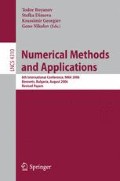Abstract
It is important to incorporate all available observations when large-scale mathematical models arising in different fields of science and engineering are used to study various physical and chemical processes. Variational data assimilation techniques can be used in the attempts to utilize efficiently observations in a large-scale model. Variational data assimilation techniques are based on a combination of three very important components
-
numerical methods for solving differential equations,
-
splitting procedures
and
-
optimization algorithms.
It is crucial to select an optimal (or, at least, a good) combination of these three components, because models which are very expensive computationally become much more expensive (the computing time being often increased by a factor greater than 100) when a variational data assimilation technique is applied. Therefore, it is important to study the interplay between the three components of the variational data assimilation techniques as well as to apply powerful parallel computers in the computations. Some results obtained in the search for a good combination will be reported. Parallel techniques described in [1] are used in the runs related to this paper.
Modules from a particular large-scale mathematical model, the Unified Danish Eulerian Model (UNI-DEM), are used in the experiments. The mathematical background of UNI-DEM is discussed in [1], [24] The ideas are rather general and can easily be applied in connection with other mathematical models.
Access this chapter
Tax calculation will be finalised at checkout
Purchases are for personal use only
Preview
Unable to display preview. Download preview PDF.
References
Alexandrov, V.N., Owczarz, W., Thomsen, P.G., Zlatev, Z.: Parallel runs of a large air pollution model on a grid of Sun computers. Mathematics and Computers in Simulation 65, 557–577 (2004)
Cao, Y., Shengtai, L., Petzold, L., Serban, R.: Adjoint sensitivity anslysis for differential-algebraic equations: The adjoint DAE system and its numerical solution. SIAM J. Sci. Comput. 24, 1076–1089 (2003)
Djouad, R., Sportisse, B.: Solving reduced chemical models in air pollution modelling. Applied Numerical Mathematics 44, 49–61 (2003)
Ebel, A.: Chemical Transfer and Transport Modelling. In: Borrell, P., Borrell, P.M. (eds.) Transport and Chemical Transformation of Pollutants in the Troposphere, pp. 85–128. Springer, Berlin (2000)
Ebel, A., Memmesheimer, M., Jacobs, H.: Regional modelling of tropospheric ozone distributions and budgets. In: Varotsos, C. (ed.) Atmospheric Ozone Dynamics: I. Global Environmental Change. NATO ASI Series, vol. 53, pp. 37–57. Springer, Berlin (1997)
Elbern, H., Schmidt, H.: A four-dimensional variational chemistry data assimilation scheme for Eulerian chemistry transport modelling. Journal of Geophysical Research 104, 18583–18598 (1999)
Elbern, H., Schmidt, H., Talagrand, O., Ebel, A.: 4D-variational data assimilation with an adjoint air quality model for emission analysis. Environmental Modelling & Software 15, 539–548 (2000)
Gery, M.W., Whitten, G.Z., Killus, J.P., Dodge, M.C.: A photochemical kinetics mechanism for urban and regional modeling. Journal of Geophysical Research 94, 12925–12956 (1989)
Gill, P.E., Murray, W.: Conjugate-gradient methods for large-scale nonlinear optimization. Technical Report SOL 79-15. Department of Operations Research, Stanford University, Stanford, California, USA (1979)
Gill, P.E., Murray, W., Wright, M.H.: Practical Optimization. Academic Press, New York (1981)
Hairer, E., Wanner, G.: Solving Ordinary Differential Equations, II: Stiff and Differential-algebraic Problems. Springer, Heidelberg (1991)
Hundsdorfer, W., Verwer, J.G.: Numerical solution of time-dependent advection-diffusion-reaction equations. Springer, Berlin (2003)
Jonson, J.E., Sundet, J., Tarrason, L.: Model calculations of present and future levels of ozone and ozone precursors with a global and a regional model. Atmospheric Environment 35, 525–537 (2001)
Lambert, J.D.: Numerical Methods for Ordinary Differential Equations. Wiley, Chichester (1991)
Le Dimet, F.-X., Navon, I.M., Daescu, D.N.: Second order information in data assimilation. Monthly Weather Review 130, 629–648 (2002)
Lewis, J.M., Derber, J.C.: The use of adjoint equations to solve a variational adjustment problem with advective constraints. Tellus 37A, 309–322 (1985)
Marchuk, G.I.: Some application of splitting-up methods to the solution of mathematical physics problems. Applik. Mat. 13(2) (1968)
NAG Library Fortran Manual: E04 - minimizing and maximizing a function. Numerical Algorithms Group (NAG), Banbury Road 7, Oxford, England (2004), http://www.nag.co.uk
Peters, L.K., et al.: The current state and future direction of Eulerian models in simulating tropospheric chemistry and transport of trace species: A review. Atmospheric Environment 29, 189–222 (1995)
Sandu, A., Daescu, D.N., Carmichael, G.R., Chai, T.: Adjoint sensitivity analysis of regional air quality models. Journal of Computational Physics (to appear, 2005)
Simpson, D., Fagerli, H., Jonson, J.E., Tsyro, S.G., Wind, P., Tuovinen, J-P.: Transboundary Acidification, Eutrophication and Ground Level Ozone in Europe, Part I. Unified EMEP Model Description. EMEP/MSC-W Status Report 1/2003. Norwegian Meteorological Institute, Oslo, Norway (2003)
Strang, G.: On the construction and comparison of difference schemes. SIAM J. Numer. Anal. 5, 505–517 (1968)
Zlatev, Z.: Modified diagonally implicit Runge-Kutta methods. SIAM Journal on Scientific and Statistical Computing 2, 321–334 (1981)
Zlatev, Z.: Computer treatment of large air pollution models. Kluwer Academic Publishers, Dordrecht (1995)
Zlatev, Z., Dimov, I.: Computational and Environmental Challenges in Environmental Modelling. Studies in Computational Mathematics, vol. 13. Elsevier Science, Amsterdam (2006)
Author information
Authors and Affiliations
Editor information
Rights and permissions
Copyright information
© 2007 Springer Berlin Heidelberg
About this paper
Cite this paper
Zlatev, Z. (2007). On Some Computational Aspects of the Variational Data Assimilation Techniques. In: Boyanov, T., Dimova, S., Georgiev, K., Nikolov, G. (eds) Numerical Methods and Applications. NMA 2006. Lecture Notes in Computer Science, vol 4310. Springer, Berlin, Heidelberg. https://doi.org/10.1007/978-3-540-70942-8_3
Download citation
DOI: https://doi.org/10.1007/978-3-540-70942-8_3
Publisher Name: Springer, Berlin, Heidelberg
Print ISBN: 978-3-540-70940-4
Online ISBN: 978-3-540-70942-8
eBook Packages: Computer ScienceComputer Science (R0)

